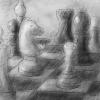I'm prototyping an action/strategy game with four damage types, and before going further I thought I'd look for some input on how people would react to such a design. By contrast, many similar games have simply a singular measure of "damage", or some cases dual damage types (e.g. physical/magical).
Four types, in my mind, represents some nice opportunities to create interesting strategic situations, which I can hopefully explain here.
The gameplay:
Mixes Tower Defense & RTS - you have a squad of three moveable "hero" units on the battlefield (before a mission they can be equipped with custom guns and armour), that form the most vital aspect of passing each level.
Rather than just having plain damage, and some amount of armour leading to "plain damage resistance", I've opted to have:
- physical DMG (bullets / ballistic)
- energy DMG (sci-fi type weapons - pulse cannon, phaser rifle etc)
- fire DMG (grenades, missiles, rockets, napalm)
- chemical DMG (special weapons, acid, toxic, etc)
The above listed types are not augmenters or additional effects - these are THE damage applied - one of the above depending on the weapon (also considering weapons with more than one type).
Additionally, each hero and enemy has one or more resistances to the above DMG types ranging from 0 (not resistant) to 100 (immunity), depending on equipped armour and innate class traits. Heroes and enemies can have any combination of multiple resistances.
Some reasons for this design:
With a lot diversity in what various enemy units can be resistant to (and what they inflict), the constantly changing strategic importance of different weapons and hero classes can maintain a kind of depth that keeps the player adapting, and (hopefully) engaged.
One reason for four types specifically, is that with a squad of three, levels can (theoretically) be designed that no amount of over-levelling or extreme supergear can simply breeze through. In an extreme example, a level could be created with at least one enemy per dmg type that's invulnerable to all but one type of weapon, meaning the player might annihilate 75% of the level easily but still need to resourceful and use good tactics against the remaining element.
My concerns:
FIrst and foremost, four damage types is a difficult thing to depict in the game's UI/menus in a way that won't confuse some people. I feel at risk of creating a system that others won't understand, and depth is only depth if it's actually understood.
Second, and this is something I'd love to hear feedback on; is this design too far outside genre norms? I'm not looking to break any genre rules just for the hell of it. I'm designing a system that I think I'd love to play myself, but there's no sense alienating others. One example of a game with this type of dmg system is Ni No Kuni (iirc, familiars have varying dmg types and inflict that type only). On the flip-side, I think of Borderlands - which has "damage", in a basic sense, and then ADDITIONAL dmg, e.g. fire, as an augmenter.
..
I think that about sums up where I'm at. I'd love to hear thoughts from others on this. And if there are any other reference examples (particularly in games that were successful and well known), they would make a really useful case study for me.
Hope all of that made sense.




